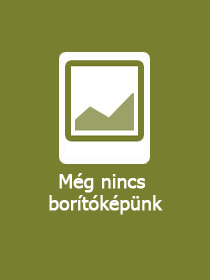
Right and Left in Early Christian and Medieval Art
Sorozatcím: Art and Material Culture in Medieval and Renaissance Europe; 16;
-
8% KEDVEZMÉNY?
- A kedvezmény csak az 'Értesítés a kedvenc témákról' hírlevelünk címzettjeinek rendeléseire érvényes.
- Kiadói listaár EUR 152.00
-
64 478 Ft (61 408 Ft + 5% áfa)
Az ár azért becsült, mert a rendelés pillanatában nem lehet pontosan tudni, hogy a beérkezéskor milyen lesz a forint árfolyama az adott termék eredeti devizájához képest. Ha a forint romlana, kissé többet, ha javulna, kissé kevesebbet kell majd fizetnie.
- Kedvezmény(ek) 8% (cc. 5 158 Ft off)
- Discounted price 59 320 Ft (56 495 Ft + 5% áfa)
64 478 Ft

Beszerezhetőség
Bizonytalan a beszerezhetőség. Érdemes még egyszer keresni szerzővel és címmel. Ha nem talál másik, kapható kiadást, forduljon ügyfélszolgálatunkhoz!
Why don't you give exact delivery time?
A beszerzés időigényét az eddigi tapasztalatokra alapozva adjuk meg. Azért becsült, mert a terméket külföldről hozzuk be, így a kiadó kiszolgálásának pillanatnyi gyorsaságától is függ. A megadottnál gyorsabb és lassabb szállítás is elképzelhető, de mindent megteszünk, hogy Ön a lehető leghamarabb jusson hozzá a termékhez.
A termék adatai:
- Kiadó BRILL
- Megjelenés dátuma 2021. március 4.
- ISBN 9789004448254
- Kötéstípus Keménykötés
- Terjedelem300 oldal
- Méret 235x155 mm
- Súly 732 g
- Nyelv angol 0
Kategóriák
Rövid leírás:
Robert Couzin?s Right and Left in Early Christian and Medieval Art provides the first in-depth study of handedness, position, and direction in the visual culture of Europe and Byzantium from the fourth to the fourteenth century.
TöbbHosszú leírás:
Robert Couzin?s Right and Left in Early Christian and Medieval Art is the first in-depth study of handedness, position, and direction in the visual culture of Europe and Byzantium from the fourth to the fourteenth century. Heretofore largely unnoticed or ignored, the pre-eminence of the right and lapses or intentional departures from that norm in medieval imagery are relevant to such major themes as iconography, visuality, reception, narrative, form, gender, production, and patronage. The author?s investigation of right and left in visual culture is informed by modern experimental research on laterality and contextualized within prevailing theological doctrines and socio-cultural practices.
Illustrations in the text are complemented by hundreds more made available on Brill's Arkyves platform here.
See inside the book.
"Dans cet ouvrage, Robert Couzin s?interroge sur les relations entre la gauche et la droite et leur capacité ? sous-tendre la composition
de l?image médiévale. Le corpus iconographique rassemblé par l?auteur est varié, réunissant différentes techniques et divers supports, autant en Orient qu?en Occident, le tout sur une période d?environ mille ans. [...] R. Couzin propose une étude originale qui éclaire différemment des aspects compositionnels et sémantiques de l?image paléochrétienne et médiévale en s?attachant aux relations entre la gauche et la droite. Au-del? d?une réflexion sur les enjeux de la prééminence du côté droit dans l?art médiéval, l?auteur met en lumi?re tout un jeu de relations, jusqu?ici peu examiné sous cet angle, entre les figures, les gestes, les objets et les inscriptions dans l?image."
Raphaël Demes, in Francia 2022 (1).
"In this fascinating, well detailed, and richly illustrated study, Robert Couzin examines the significance of right- or left-handedness in eastern and western Christian visual art from the fourth through the fourteenth century.[...] The closing pages of the book strongly advocate the value of the study and criticize art historians who are inattentive to the significance of right and left. Couzin equates that inattention with failing to notice such other features as use of materials, application of color,or differences in style or technique. Couzin further laments that the matters he discusses have "gonelargely unnoticed" and are "underappreciated" when they are noticed (242). His case is well made, even if it makes a somewhat contentious final statement. Thankfully,with the publication of this erudite and detailed volume, that nolonger can be said.
Robin M. Jensen, University of Notre Dame, in The Medieval Review 22.01.2022
Tartalomjegyzék:
List of Illustrations
Abbreviations
Introduction: The Pre
-Eminence of the Right
1 On Human Handedness
2 The Sublimation of Right and Left
3 Historiography
4 Plan of the Work
Part 1: The Right Hand
1 Picturing Handedness
2 The Hand of God
1 The Great Right Hand
2 The Other Hand of God
3 God in the Image of Man
3 Fighting and Writing
1 Handedness and Violence
2 Handedness and the Scribe
3 The Pen and the Sword
4 A Digression on Feet
1 Stepping Up to the Altar
2 Figures in Motion
3 Footwashing
4 The Three
-Nail Crucifixion
Part 2: The Right Side
5 Picturing Position
6 Peter and Paul in Early Christian Art
1 Double Portraits of the Chief Apostles
2 Peter, Paul, and Jesus
3 The Politics of Apostolic Precedence
7 Spouses: The Place of Gender
1 Early Christian Men on the Left
2 Medieval Men on the Right
3 Transgression: Medieval Women on the Right
4 The Coronation of the Virgin: Sponsa on the Right
Part 3: The Right Way
8 The Pythagorean Y
1 The Two Ways: Pythagoras and Matthew
2 Erlangen Universitätsbibliothek, Ms. 8, fol. 130v
3 The Pilgrim?s Choice
4 A Matter of Mentality
9 Sacred Movement
1 Depicted Motion in Latin
- and Greek
-Language Cultures
2 The Syriac and Hebrew Evidence
3 Conclusions
10 Narrative Sequence
1 Script Direction and Pictorial Programming
2 Linear Programs and the Puzzle of Bernward?s Column
Epilogue
1 Misapprehension
2 Inattention
3 Disinterest
4 Future Directions
Bibliography
Index
Több




